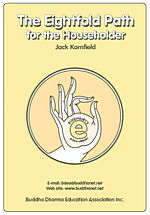An everyday guide to the Eightfold Path

DOWNLOAD BOOK:
The Eightfold Path for the Householder (Ten Dharma talks) by Jack Kornfield,www.buddhanet.net (PDF, 488 KB)
ONLINE VERSION:
www.dharmaweb.org

 It's not a judgment but rather realizing we have this capacity, we have a beautiful capacity to suffer and we have a beautiful capacity to love, and we have a beautiful capacity to open to the richness of our experience which has all that in it - what's joyful, what's unpleasant - so that the attitude of practice is like a flower blossoming. You started, so it's happening anyway, but you can help it.
It's not a judgment but rather realizing we have this capacity, we have a beautiful capacity to suffer and we have a beautiful capacity to love, and we have a beautiful capacity to open to the richness of our experience which has all that in it - what's joyful, what's unpleasant - so that the attitude of practice is like a flower blossoming. You started, so it's happening anyway, but you can help it.
A description of the eightfold path would form part of a basic explanation of Buddhist practice, one that is often encapsulated in 16 words because it is easy to do so. And the path could sound different to different people depending on their understanding of its relevance in the larger context of Buddhism or indeed one's grasp of its dimensions.
The word right 'right' that preceeds each of the eight constitutents of the path is related to Buddhism is an essential way. It is not the merely the ethical right and wrong that is in focus, there is a transcendental dimension to it.
It is in bringing out the transcendental essence of the path that Jack Kornfield succeeds so well. He relates each element of the path to a larger context, while at the same time outlining its contours by relating it to the various facets of everyday living.
That he is open to using various other texts enriches his explantions in this book, which is made up of a compilation of his talks. So it is that the book comes interspersed with quotes from Carlos Casteneda, the Bhagvad Gita, T. S. Eliot, James Joyce, William Blake, Krishnamurti and so on. And there are even exercises to help one with one's practice.
The different chapters provide all that is required for an essential understanding of Buddhism. The first chapter on Right Understanding deals with meditation in a detailed way, for instance.
'Right concentration', centers around a fairly description on to use one's breath in practical ways to foster one's practice. And the last chapter, on Right Awareness, deals with developing mindufulness, again in some detail.
The chapters go into the fundamentals of following the eightfold path in our day to day lives.
The chapter on Right Attitude, offers interesting exercises. And he has the answer to the intriguing question, is there such a thing as the 'perfect job', in the chapter, Right Livelihood. Here he also talks about bringing mindfulness to one's daily work. The power of speech and using it the proper way to nurture one's awakening is one of the key points dealt with in the chapter Right Speech.
This brief description of the book does no justice to the richness of the multiple dimensions of Buddhism that Jack Kornfield unfolds for our benefit. Hopefully, it offers a glimpse or two into what the book is about.